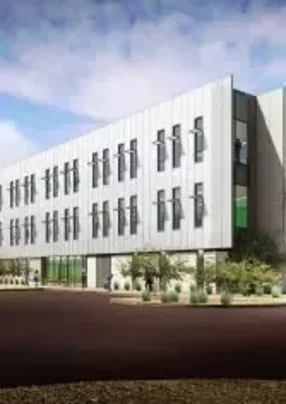Arizona’s pride and joy, the Sky Harbor International Airport, is getting a makeover. The renowned airport — located in the heart of Phoenix, three miles southeast of downtown— serves nearly 40 million passengers every year and has become a mainstream destination for travelers. With those numbers projected to grow considerably by 2019, the airport is undergoing an expansion project to accommodate the rising growth while also creating a world-class traveling experience for passengers.
Modernization Project
The need to expand Sky Harbor is clear. The day after the 2015 Super Bowl the airport set a one-day record for passengers. Another record was set in March, when monthly traffic came in at a staggering 4.25 million passengers. To keep pace with growth in the area, the City of Phoenix has greenlit a five-year, $590 million design-build project known as the Terminal 3 Modernization Program at Sky Harbor International. This project, which aims to accommodate the expanding demand on the airport, will benefit generations to come.
The expansion will take place in three construction phases over a five-year period. The first will expand security checkpoints at Terminal 3, while the second phase will expand ticketing and baggage claim, concessions and passenger load and unloading areas. Finally, the third phase will add nine gates to the South Concourse.
Renovations include the South Concourse, which will feature a new passenger concourse consisting of a passenger level and an apron level for service and support functions. Meanwhile, the North Concourse is set to undergo a comprehensive renovation of the passenger and apron levels including 10 gates, with an expansion at the mid-point as a ’node’ to accommodate additional amenities.
Phoenix’s finest
Under the leadership of Austin Commercial and joint venture partner Hunt Construction, the project will include expanded and upgraded checkpoints, additional ticket counters, baggage processing capacity, baggage claim carousels, gates, and expanded food concessions and retail stores, along with the installation of dynamic signage to direct traffic around the airport.
“The project is very unique in terms of the two companies working together, combined with the design and build aspect,” said TG Mason, project manager for the Modernization Program.
“For this project we had a three-headed design team. DWL Architects and Planners were the original designers for Terminal 3 and took the lead. They have a tremendous amount of experience here in Phoenix.”
According to Mason other collaborators included Dallas-based Corgan, an international leader in aviation, and The Smith Group, one of the oldest continually operating architects in the United States for the last 100 years.
“We looked to them as the design visionary, to bring the contextualization of Phoenix to the airport,” said Mason. “With everyone together it creates a unique a team. There’s lots of industry insight and collaboration going on, and I think it’s best for the project.”
Echoing the sun-emblazoned Arizona state flag, a unique feature of the expansion project incorporates one of the most pervasive symbols of Phoenix.
“We had one of our design partners use their proprietary software to map the patterns of the sun during the year because we wanted to design the building so it could maximize light from the sun,” Mason said.
He added the project is also aiming to be LEED silver certified part, as most of the material being used is recycled.
Challenges
For HuntAustin, the primary challenge for the Modernization Program lies in the fact Terminal 3 has remained — and will continue to remain — in operation during construction.
“It’s kind of like performing heart surgery,” said Mason.
Determined to live up to Sky Harbor’s motto of “America’s Friendliest Airport,” Hunt Austin is committed to making the construction efforts as painless as possible.
“We’re doing this in phases in order to minimize the impact on travelers,” Mason said. “We interface with our team regularly and coordinate with the airport to reduce impact. The focus is on the customer.”
The first phase was completed earlier last year, while phase two is scheduled to be finished in late 2017. The project is expected to be fully completed by 2020.
“When phase one opens it will include state of the art security checkpoint,” said Mason. “It uses the latest technologies in aviation and TSA to create a comfortable feeling for passengers.”
“A project is only as good as its people”
According to Mason, a majority of the subcontractors used were local to Phoenix, or had local offices. “We wanted to find local expertise and maximize the local workforce and small business.
“One of the things I can’t stress enough is that a project is only as good as its people. We’ve been very fortunate with Hunt and Austin to pull forward this great team,” said Mason. “Everyone has worked really well together, taking a lot of pride in the project. They’re proud to put their name on this. There’s a lot of personal satisfaction for me as well.”


